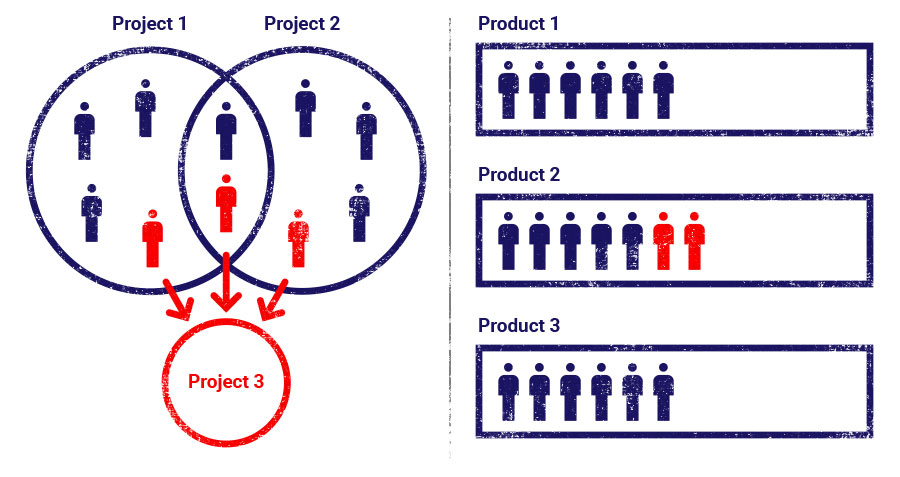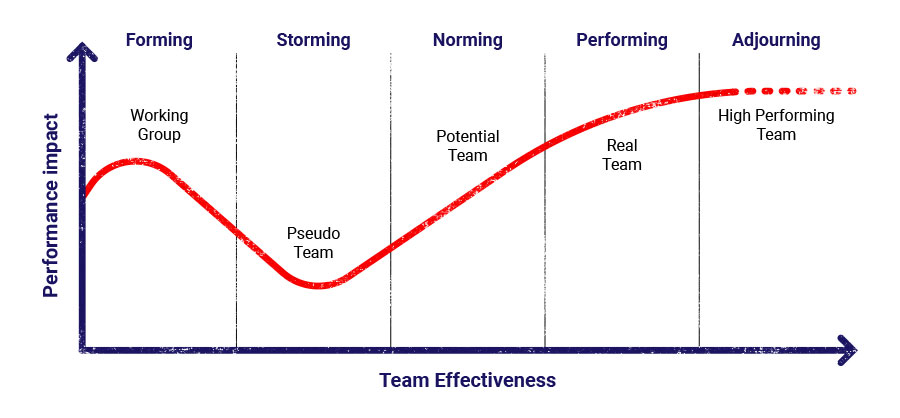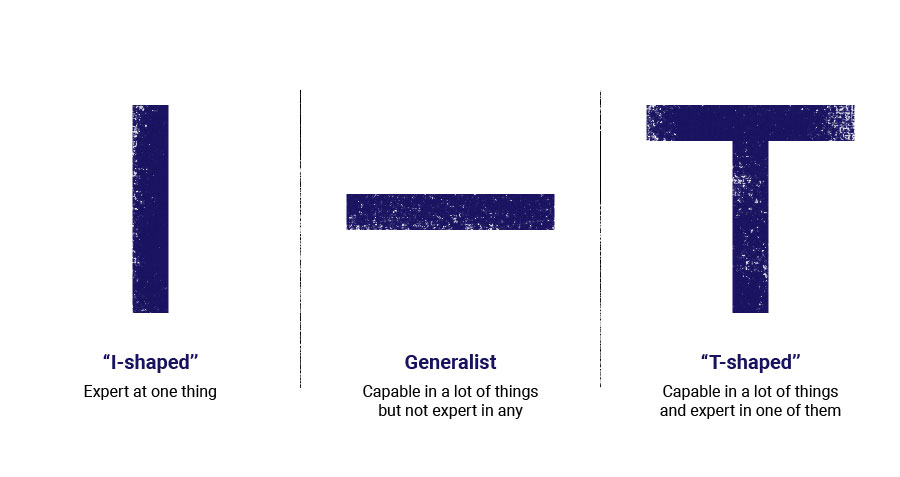Project Team
Many service companies, in the digital product market, when they first interact with Scrum or with other Agile frameworks, they start using the methodology about Project Team.
The client is usually accompanied throughout the initial phase by the Business/Sales team of the company and then helped by a Product Owner, especially during the process of design and development. The Product Owner interacts with Designers, Developers and Technical Teams, whose size depend on how big the project is and, usually, it is carried out by team members with a very well-balanced seniority.
Project Teams are those teams that are created when a project kicks off and they stay together for the whole duration of the project. They regularly meet for ceremonies and they can rapidly and regularly give value to the client.
This is an improved and important way of delivering results compared to past ways of working.
Even if, sometimes, some components can be used for a limited time, the Team is entirely involved in the whole analysis and development of functionalities, until testing and release come into play.
The Team is later dismembered gradually, as soon as the product becomes stable in production and it enters the support phase.
In that particular moment, the professionals who used to be part of such a Team can now help supporting other Teams or can also be allocated to new projects when available.
Stable Team
A very interesting trend which has been deeply analyzed in the past few years, is the tendency organizations have to move towards the so-called “Stable Team” or “Stable Product Team” or “Long-Term Team”.
The name gives already a good explanation: these are Teams that will stay together for a longer period of time, way beyond the duration of a single project.
In the best hypothesis, teams have multidisciplinary competencies and they can deal with a project from the start to its end.
The members of these teams are working full-time on the same assignment and, once finished, they are ready for the next one.
When a new project comes up, it is taken by the mostly free and competent team or, if it’s too challenging, it can be split across several teams.
We can look at the distinction of the two models in this way:

Group Dynamic
In 1965, Bruce Tuckman, a Professor of Educational Psychology at Ohio State University, elaborated an evolution model called “Tuckman’s stages of group development” for the working environment.
The 5 stages that Tuckman identified are still a valid point for people who are involved in such domain:
- FORMING
The Forming phase is when the Team develops a sense of belonging through trust, shared values and mission. The leader or coach is a very important figure as the roles, at this stage, are not clear yet. This means that reciprocal expectations and objectives are not obvious either and Team members need to have someone who can help them develop a bonding feeling whilst making all the different personalities work towards the common goal. - STORMING
This is the phase where conflict prevails. Everyone tries to impose their individuality, generating conflict with other members of the team and creating resistance to the group formation. The leader/coach will need to ease the tensions, giving the team the tools to find some balance for the need of working together and the natural vocation of individualism. Every situation of conflict can bring uneasiness and doubt but it can certainly be a way of learning and will offer the opportunity of strengthening relationships. - NORMING
The third phase (also called normalization) expects overcoming all conflicts. A sense of unity is created and all members start feeling part of the team. In such phase rules, methods and tools are decided so everyone can have a clear idea about values and objectives that need to be reached. This will result in a growth of trust towards everyone in the team. - PERFORMING
The fourth phase of the group dynamic is defined by Performing. Once the relational issues have been overcome and rules established, the real work with the leader/coach begins. This gives space to the group to work on its own in order to have self-esteem and the right level of trust to make things different from a qualitative perspective. The higher the trust, the easier failures can be analyzed and turned into opportunities which make the team grow. - ADJOURNING
The last phase is the one where all tasks are completed. Usually, this is when a decrease in commitment and motivation happens. The good leader will take this as the chance to elaborate and work on new projects and objectives and start a new forming phase.

What indicator can we use to measure a successful team?
We do think that performance is measured through skills, cleverness, ability, synergy or even leadership. This is not correct and what makes a team successful is the security perception.
People feel at ease, strong and confident when they can work together in a continuous and focussed way, having clear objectives in mind and knowing who to go to when they need advice.
In safe environments, the chances for people to share ideas and finding new methods are higher. This is because people do not feel threatened by being judged or, worse, punished.
Every time a Team is dissolved to form a new one, every single member needs to start again.
To build trust and collaboration within a team a lot of effort and dedication are needed.
More trust gives more willingness to work together and this translates into productivity.
Often it is best to give to a mature Team a task that is quite different from the current Team’s skill set rather than giving it to a Team that still needs to go through all Tuckman’s phases.
Very performing teams will have no difficulties in gaining the competencies required by the new project and will therefore increase their efficiency.
Why should a business opt for Stable-Teams?
Many businesses see creating stable teams impossible in their market or condition.
Too many projects, too lees resources, turnover, and junior members are a complicating factor in the organizational picture.
This reveals reals problems that go a bit beyond the obvious: who takes decisions? How are priorities decided? How transparent is the communication? How is the short-term vision planned?
Stable-teams arrive to support all these issues in the following ways:
- In a service company, that no longer do product, the members of a stable Team might have to face different projects at the same time but the colleagues and the leader remain the same. It allows to maintain the focus and to optimize times for meetings, calls, and alignments.
- The time for the project start-up is reduced, if not entirely canceled. These are times in which Team members can get to know each other, also from a technical perspective. Organizational dynamics are put in place.
- Information circulates in a more direct and efficient way amongst a well-oiled team. Furthermore, the natural sharing of knowledge brings the development of the so-called T-shaped skill-set, some deep competencies in a specific specialized domain and more generic on other topics.


- A project lead can easily control all the tasks of the team, no matter how variable they might be. This means that everything will be under the leader’s management and there will be no interferences nor external dependencies aside from his knowledge.
- There is clearly a cut in the costs related to “Team resources” as it is no longer needed to dismantle and create new project teams. This also translates into a no longer need for cross checks about existing projects performance, linked to taking resources away.
- Better Teams are built. Whilst building a Project Team there is the tendency of using available people (those who are on the bench). With the approach of a Stable Team instead, there is a motivation for building a Team with the right people. This sees the Team starting by itself, only inviting people with whom there is already a professional experience in place.
- Teams have more probabilities of getting better. When a Team has been working together for a long time and when it is responsible for the whole cycle of the project, from start to end, it is highly probable that their work will be streamlined so processes can be more efficient.
- It is a lot easier for the Product Owner to monitor progress (or not) of the team and he/she will have more elements to estimate projects which are about to start or forecast how the ones already started, will be going.
An example of Velocity Chart of a developing Team (screenshot taken from Atlassian Jira) shows the increase of performance of a Team from Sprint to Sprint (a variable period, usually 2 weeks). The Team is able to give more quality which is depicted by the green columns in the graph:

It is now relevant, to be intellectually correct, to also talk about the possible negative things:
- After a while, some people might get bored to interact always with the same people. Frictions, lack of understanding and non-virtuous habits might emerge.
- The “boredom” factor might be linked to the technologies and tools used or there might be a sense of limitation regarding professional growth. We are talking about knowledge worker; whose peculiarity focuses on constant learning.
- “Group thinking” is another risky behavior that might emerge with time. It is the uniformity of thinking of every individual, generated by routine.
Stable Team = “Stagnant” Team?
A stable team doesn’t necessarily mean “stagnant”: changing is always possible!
It is part of a leader/coach’s task to identify the alarming bells, encouraging discussions with people, evaluate what can be easily solved, promote opportunities for growth and, eventually, restructure the Team.
Sometimes the team might need to become bigger or smaller, other times it will be obvious that some people do not work well together and that others have a great understanding. Taking away or adding a person to the team is something often needed to “wake up” the team from a period of slumber.
There are infinite reasons why Stable Teams evolve in time and this is positive both for the Team and the organization that becomes more mature and subsequently grows.
People who are leaders or coaches play an essential role in this type of organization, which cannot be confused with a more standard hierarchy.
Servant Leadership or Participating Leadership styles enrich the work done by teams who feel part of the decision-making process and, at the same time, are represented in front of top management.
It is right to recognize that those who support daily management, making internal and external relationships easier, paying attention to human dynamics (on top of professional ones) become focal points.
“Employability is having a set of skills, knowledge, understanding and personal attributes that make a person more likely to choose and secure occupation in which they can be satisfied and successful.” Dacre Pool and Sewell, 2007
In big companies, where it is difficult for HR departments to enter the complexity of daily assignments and to understand feelings, issues and unhappiness, the roles who help the operations side of things offer an important contribution. They decentralize the attention for the person and this makes it more punctual and significant.
Marco Calzolari, co-founder of Agile Reloaded and Nobilita, during the workshops titles “Everyone is HR”, summarised in this way the responsibility of the company’s performances:

Even if individuals are responsible for their own personal development, the company has to create the condition to favor such development.
When we talk about “company” we are not just referring to the CEO, CTO or HR Managers.
The company needs people to trust, in every part of the organization, in order to be ready to understand and drive changes.
You might also like:
T-E-A-M: Together Everyone Achieves More
Connecting Passions
Soft Skills, handle with care



